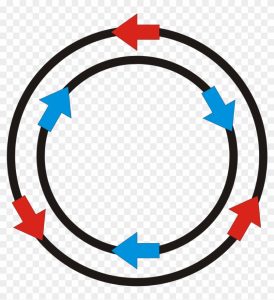As a restorative practices trainer and consultant, I challenge educators to build relationships with students. When working with secondary educators, I often hear, “I don’t do relationships, I teach …”
But there’s good news. When I do training, I use concentric circles to review restorative practices principles. The easiest circle secondary teachers can use is the concentric circle. This is a perfect strategy for doing a review before a unit exam. Elementary teachers call this strategy inside outside circles.
Concentric Circles Structure
To create two concentric circles, ask the students to form two circles, an inside circle and one outside circle. The easiest way to get students into two circles is to have half the students form an outer circle usually around the perimeter of the desks. Then instruct the remainder of the students to find a partner in the first circle and face each other. Let students know that they are not staying with this partner for very long or they take too long to select someone. This creates the inner circle. The first time you ask students to do this, it will take a few minutes. With practice, students will get into concentric circles quicker.
How to Do the Review
Each student on the inside is paired with a student on the outside; they face each other. If you have an odd number of students, one “pair” will have a third student. This strategy engages students who may not typically work together. When the students are in their circles, the teacher asks a review question to the whole group. Each pair discusses their response with each other. This engages all the students simultaneously. Students with limited English proficiency can easily participate. What I love about this strategy is that if the partners don’t know the answer, they may naturally eavesdrop on those nearby.
When the noise level drops, you’ll know that it’s time to instruct the students on the outside circle to move one space to the right so they are standing in front of a new person. Next, the teacher poses a new question, and the process is repeated. This works well for about six to seven review questions. As students get accustomed to concentric circles, you can lengthen the time by asking more questions.
Parallel Line Option
This strategy can also be done with two parallel lines instead of circles. When I use lines, I call it “Line-up Review.” Depending on your classroom space, two parallel lines may work better than a circle.
If you’re a secondary educator, I encourage you try the concentric circles for review. I’d love to hear how it goes.
Resources
To learn more about this read Inside/Outside Circles or Circle Conversation created by Spencer Kagan in 1994 at https://teachingrecipes.com/wp-content/insideoutsideactivity.pdf.
You can also view the six-minute video Discovering Voice: Inside-Outside Circle. In this video, the teacher numbers students as a one or two. Students move in opposite directions until the bell rings. When they hear the bell, they stop and talk with their new partner.
Image source: students-inside-outside-circle 238-2383883 [clipartmax.com]
